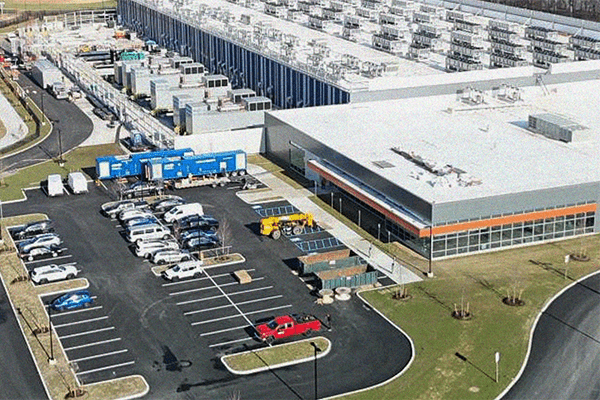|
RCBJ-Audible (Listen For Free)
|
Databank Proposes Doubling Its Footprint & Capacity Despite County & Resident Opposition
More than 100 Orangetown and New Jersey residents packed a standing-room only Orangetown Planning Board meeting late last month to raise objections to a proposal to build a data center on the shores of the Tappan Reservoir. The unusual meeting was more “workshop” than site plan approval because Databank came for “feedback” from town officials, the town-hired planning consultants from AKRF, and the public on its plan to build a 146,000 square-foot facility to accommodate the growing demand for AI.
There was no shortage of feedback, particularly from an angry and worried crowd that urged town planners to deny the application when the time was ripe, saying another data center would pose a threat to quality of life, wetlands and wildlife, the adjacent Lake Tappan Reservoir. And it would tax the electrical grid. But the developer said the application should be approved, positioning the project as a Phase II staging of the 141,000 square-foot datacenter on 2000 Corporate Drive Orangetown approved in 2022.
Orangetown has become Rockland County’s go-to for data centers, which include Bloomberg, JP Morgan Chase, and Databank’s first facility. The large structures boost the tax base and have low traffic impact because they typically hire small staffs. However, there is growing concern over the consumption of electricity, as well as the nuisance the centers cause to nearby residents who suffer with humming noises from ongoing operations, exhaust from generators, light pollution, and blighted viewsheds.
Databank’s first facility, which sits on the same parcel where it hopes to build a second center, opened in May. The 20 megawatt (MW) facility is part of Databank’s three interconnected facilities in New York. Phase II, if approved, would mark its fourth in New York State. Databank has more than 65 data centers in the U.S., according to the company’s website.
Databank’s Phase II application, which has been before the board since 2024, is seeking approval for the construction of a 146,000 square-foot data center, a 7,900 square-foot expansion of its Phase I building, construction of a 73,000 square-foot grid-connected substation, and a 52,000 square-foot equipment yard. Phase II would add another 20 megawatt of capacity. A megawatt (MW) is a unit of power equal to one million watts or 1,000 kilowatts. One MW can generally power between 800 and 1,000 homes in New York.
Data centers measure capacity by megawatts (MW) of critical power. Databank says its expansion plans will boost power usage to 45 MW, enough to power up to 45,000 homes.
2000 Corporate Drive sits on the border of New York and New Jersey, adjacent to Lake Tappan, a protected reservoir. The Orangetown Zoning Board of Appeals in 2022 granted Databank several variances, including a reduction in parking requirements and proximity to the R-80 residential district, before the Planning Board granted site approval for the first building.
Members of the Planning Board peppered the developer with questions, mostly about the amount of electricity the data center would use, where it would get the power from, and how the surrounding community would be affected. Concerns were raised about who would get power first in a black out, and how the costs of improving the transmission lines and power grid would impact ratepayers in Orangetown and Rockland County.
Issues raised by AKRF largely focused on preparing a “Part II” Environmental Assessment Form (EAF) to aid the planning board in determining the scope and extent of environmental review for the purposes of the New York State Environmental Quality Review Act (SEQRA). Although both the developer and the planning board agreed the project was a Type I Action (a project presumed to have a significant adverse environmental impact, which would require a thorough environmental review), no SEQRA determination was requested or made.
Residents argued that the project is not an “as-of-right” application because data centers are not specifically provided for as a “permitted use” in the Orangetown Use Table for the LIO zone. There had been discussions at the Town Board to consider amending the LIO Zone to allow data centers with “conditional use standards” as part of implementation of the town’s Comprehensive Plan, but no local law has been passed to implement that change.
Nevertheless, Lino Sciaretta, counsel for Databank, repeatedly emphasized that the LIO zone has several other data centers operating, including Bloomberg, JP Morgan Chase, and Databank Phase 1. The LIO zone uses are primarily industrial and commercial, with specific regulations for uses like warehouse, distribution, and manufacturing.
“Orangetown has already permitted other data centers, so based on past interpretations, that ship has already sailed,” he said.
Zach Rome, a Nyack resident, argued that there has never been a use determination by either the planning board or the zoning board of appeals. He said the only decision was a “Building Permit Referral” by the town’s building inspector, not an actual determination by the ZBA. The issue, he says, was never decided by the ZBA when variances were sought for approval of Phase I.
The Rockland County Department of Planning agreed with that assessment, saying data centers were not permitted uses in the LIO and that a use variance should be required.
Another hotly debated issue at the meeting centered on Phase I and land banking for parking spaces, which allows a developer to hold land for future parking instead of developing it at the time it builds its project. When Databank received variances and approvals for Phase I, one condition of the approval required Databank land bank about 700 parking spaces. While data centers have few employees and require few parking spaces, a future or alternative user of the building may require additional parking. Land banking those spaces ensures land will be available, if and when those spaces are needed.
In September, 2022, the ZBA specifically conditioned approval for a parking variance based on a requirement to land bank parking spaces. 69 spaces were approved with the condition that Databank provide 671 land banked parking spaces on the site. Databank is proposing only 105 of the 1,264 parking spaces required for Phases 1 and 2 together, and no land banking, even though it accepted the condition that land had to be reserved for parking as part of its earlier variance approval.
“AI isn’t going anywhere, anytime soon,” said Dana B. Smith, Construction Project Manager for Databank. “We won’t need that land I assure you.”
At a meeting of the Rockland County Planning Board last December, the Board expressed concern over Databank’s inability to commit to this previously approved condition by the ZBA. The board has also raised issues with the disruption to wetlands, high level energy usage, lack of parking, and fire safety issues.
Questions remain over energy usage, the source of the energy, the ability of O&R to provide the energy, how energy would be allocated during power failures, and who would pay the costs of the grid upgrades. The planning board required Databank to provide a detailed analysis as part of its application for site plan approval.
One resident suggested the planning board defer to a more qualified body to act as “lead agency” for purposes of SEQRA, saying multiple towns, and bi-state impacts warranted the New York State DEC or the county to be lead agency, but after public comment was heard, the planning board voted itself to be lead agency for SEQRA review.
White Plains-based attorney Clifford Davis, who is representing the residents, was not present at the meeting, but submitted a letter challenging data center use in the LIO district, demanding compliance with the land banking commitment, and insisting that a positive SEQRA declaration be issued and a full Environmental Impact Statement (EIS) be prepared.
Noise and light issues were also raised, with residents saying the facility was lit up like a football field. Other residents complained about the “constant hum” emanating from the Phase I site that could be heard across Lake Tappan. Some complained about offensive odors coming from the exhaust of diesel generators that are tested regularly. The facility relies on diesel generators as back-up power in the event of a power failure.
Lithium-ion batteries are often used to provide uninterrupted power in the event of a grid failure or power outage. Databank’s manager said the facility does not rely on lithium-ion batteries for back-up power. In both data centers, diesel generators would trip on in the event of a power failure and could supply the facility with power for 24 hours at full usage, or longer at less than full usage. The diesel generators could be resupplied with fuel during an outage to maintain uninterrupted power.
Data centers are notorious for excessive water use, but concerns about water use were mitigated when Databank’s engineer explained the buildings use a closed loop system to cool the processors, mitigating the concerns about excessive water use.


















